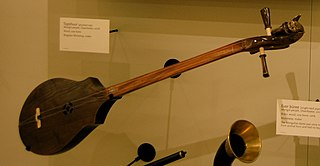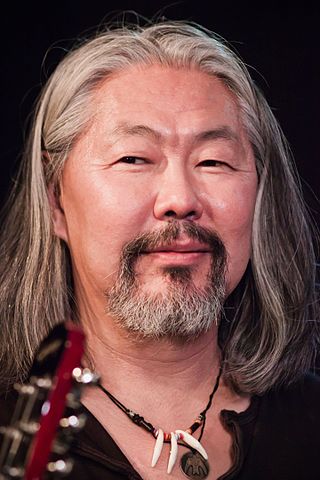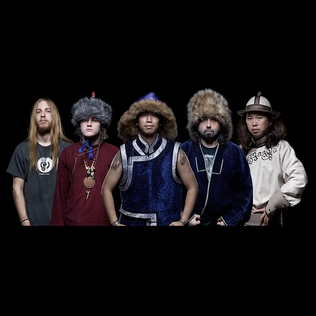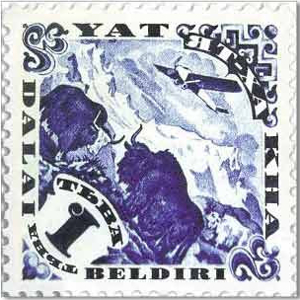
Music is an integral part of Mongolian culture. Among the unique contributions of Mongolia to the world's musical culture are the long songs, overtone singing and morin khuur, the horse-headed fiddle. The music of Mongolia is also rich with varieties related to the various ethnic groups of the country: Oirats, Hotogoid, Tuvans, Darhad, Buryats, Tsaatan, Dariganga, Uzemchins, Barga, Kazakhs and Khalha.

The morin khuur, also known as the horsehead fiddle, is a traditional Mongolian bowed stringed instrument. It is one of the most important musical instruments of the Mongol people, and is considered a symbol of the nation of Mongolia. The morin khuur is one of the Masterpieces of the Oral and Intangible Heritage of Humanity identified by UNESCO.

The Tuvans or Tyvans are a Turkic ethnic group indigenous to Siberia who live in Russia (Tuva), Mongolia, and China. They speak Tuvan, a Siberian Turkic language. In Mongolia they are regarded as one of the Uriankhai people groups.
The igil is a two-stringed Tuvan musical instrument, played by bowing the strings. The neck and lute-shaped sound box are usually made of a solid piece of pine or larch. The top of the sound box may be covered with skin or a thin wooden plate. The strings, and those of the bow, are traditionally made of hair from a horse's tail, but may also be made of nylon. Like the morin khuur of Mongolia, the igil typically features a carved horse's head at the top of the neck above the tuning pegs, and both instruments are known as the horsehead fiddle.
Paul Jerrod Pena was an American singer, songwriter and guitarist of Cape Verdean descent.
Tuva is a part of Russia, inhabited by a Turkic people. Tuvans are known abroad for khoomei (xöömej), a kind of overtone singing.

Huun-Huur-Tu are a music group from Tuva, a Russian federative republic situated on the Mongolia–Russia border. Their music includes throat singing, in which the singers sing both a note and its overtones, thus producing two or three notes simultaneously. The overtone may sound like a flute, whistle or bird, but is solely a product of the human voice.

The tovshuur, also known as topshur or topshuur is a two or three-stringed lute played by the Western Mongolian (Oirats) tribes called the Altai Urianghais, the Altais, Tuvans, and Khalkha peoples. The topshur is closely tied to the folklore of Western Mongolian people and accompanied the performances of storytellers, singing, and dancing. According to descriptions given by Marco Polo, the Mongols also played the instruments before a battle.

Robert David "Lu" Edmonds is an English rock and folk musician. He is currently, as of 2018, a vocalist and saz and cümbüş player in the Mekons and the guitarist for Public Image Ltd. Edmonds reportedly plays electric guitar, bass guitar, keyboards, bouzouki, saz, cümbüs, oud, and drums, among other instruments.

Albert Budachievich Kuvezin is a Tuvan guitarist and throat singer.

Vihma is Värttinä's 7th album, released in 1998. It is primarily pop- and rock-influenced Finnish folk music. However, three tracks also include Tuvan throat singing.

Tyva Kyzy is an all-female folk ensemble performing Tuvan throat-singing, under the direction of Choduraa Tumat. It is the first and only women's group in Tuva that performs all styles of Tuvan throat-singing.

Chirgilchin, meaning "dance of the air in the heat of the day" or "miracle" in Tuvan, is a group of Tuvan musicians performing traditional Tuvan music. It was established in 1996.

Mongol-Tuvan throat singing, the main technique of which is known as khoomei, is a style of singing practiced by people in Tuva and Mongolia. It is noted for including overtone singing. In 2009, it was included in the Representative List of the Intangible Cultural Heritage of Humanity of UNESCO. The term hömey / kömey means throat and larynx in different Turkic languages. That could be borrowed from Mongolian khooloi, which means throat as well, driven from Proto-Mongolian word *koɣul-aj.

Kaigal-ool Kim-oolovich Khovalyg is a Tuvan throat singer and co-founder of the Tuvan music group Huun-Huur-Tu.
Altan Urag is a Mongolian folk rock band. Formed in 2002, the band's musical style combines traditional Mongolian and contemporary influences. They're considered to be the pioneers of mongolian folk-rock.

Aldyn-ool Takashovich Sevek was a master Tuvan throat singer.

Tengger Cavalry was a heavy metal band originated from Inner Mongolia and Beijing and formerly based in New York state and Texas. They combine elements of the traditional music of Central Asia and music of Mongolia with heavy metal into a kind of folk metal that Billboard and CNN refer to as nomadic folk metal.

Soriah is an American overtone singer, performance artist, multi-instrumentalist, and shamanic ritualist headquartered in Portland, Oregon and The Tuvan Republic. His music is a synthesis of traditional forms such as Tuvan throat singing, Shamanic music, Raga, and pre-Columbian Mexica music and language; with avant garde musical styles like Industrial, Ambient, Noise, and Goth. Likewise, his live performance is a fusion of costume and ritual from Tuva, Mexico, North American Native cultures, and Western Ceremonial Magic traditions; as well as chaos magic, butoh, and modern primitive movements of the 20th century. His lyrics, when there are any, are often written in the Nahuatl or traditional Tuvan languages. He won the title of "Best Foreigner" at the 2008 Ustuu-Khuree Festival in Chadanaa Tuva, and in that same year placed as "Third Laureate" at The International Throat Singing Symposium, which remains the highest award given to a non-Tuvan in the history of the Symposium. He also won 2nd Place in the Tuvan Nation Kargyraa Competition in 2014, was given a special award as "Great innovator of the art of Tuvan Throat Singing" in 2016, and won Best Kargyraa Performance at the Khoomei in the Center of Asia Festival 2019. As a solo artist, and with various collaborators and musical ensembles, Soriah has toured throughout the United States, Europe, Asia, and Mexico. He is considered the highest-ranked non-native practitioner of Tuvan throat singing.

Dalai Beldiri is an album by the Tuvan trio Yat-Kha. It was released internationally in 1999. The album title translates as "the confluence of the seas."

















